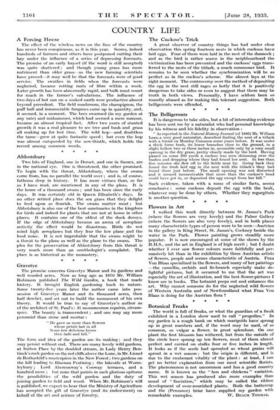Gravetye The promise concerns Gravetye Manor and its gardens and
well wooded acres. Now as long ago as 1870 Mr. William Robinson published The Wild Garden, a book that made history. It brought English gardening back to nature.
Some twenty-five .years later the author came into pos- session of Gravetye Manor and its thousand acres, then half derelict, and set out to build the monument of his own theory. It would be true to say of Gravetye's author as of the architect of St. Paul's: Si monurnentum requiris, circum- spice. The beauty is transcendent ; and one may say more perennial than stone and mortar :
" He gave us more than flowers whose petals last in all Some few delicious hours then fade and fall."
The form and idea of the garden are -its making ; and they may -persist without end. There are many lovely wild gardens, at Sutton Place by the doubled stream, in Lady Henry Ben-
tinek's rock garden on the red cliffs above the Lune, in Mr. Lionel de Rothschild's masterpiece in the New Forest ; two gardens on the hill leading to Blaenau Festiniog ; the lakeside at Worm- leybury ; Lord Abereonway's Conway terraces, and a hundred more ; but none that paints in such glorious epitome the possibilities of the wild garden and the duty of joining garden to field and wood. When Mr. Robinson's will is published, we expect to hear that the Ministry of Agriculture has accepted the gift of Gravetye (and its endo'rment) on behalf of the art and science of forestry..






































 Previous page
Previous page